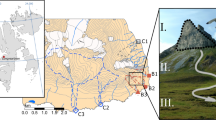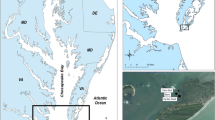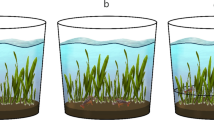Abstract
Lucinid bivalves dominate the infauna of tropical seagrass sediments. While the effect of seagrass on lucinids has been studied, the reverse effect has largely been ignored. Lucinids can alter porewater chemistry (i.e., increase porewater nutrients by suspension feeding and decrease porewater sulfides by oxygen introduction and bacterial oxidation), which can potentially change seagrass productivity and growth morphology. To observe correlations between porewater chemistry and lucinid presence, a field survey and laboratory microcosm experiment were conducted. Survey sampling sites with lucinids had significantly lower sulfide and higher ammonium concentrations than sampling sites without lucinids. There was no difference in phosphate concentration among sampling sites. Both lucinid species used in the microcosm experiment (Ctena orbiculata andLucinesca nassula) significantly lowered sulfide concentrations in the sediment porewater. Microcosm and field survey results were incorporated into a sulfide budget. In seagrass sediments, lucinids remove 2–16% of the total sulfide produced. Sulfide is a major stressor to both plants and animals in Florida Bay sediments; this removal may be important to maintaining seagrass productivity and health. Oxygen introduction into sediments byC. orbiculata was estimated in a dye experiment.C. orbiculata were added to small tubes containing sieved mud and incubated in a bath of seawater with a Rhodamine WT. Rhodamine WT accumulation in the sediment was measured. A first order estimate showed that oxygen introduction can account for less than 5% ofC. orbiculata sulfide removal.
Similar content being viewed by others
Literature Cited
Allen, J. A. 1958. On the basic form and adaptations to habitat in the Lucinacea (Eulamellibranchia).Philosophical Transactions of the Royal Society 241:421–484.
Alongi, D. M. 1998. Coastal Ecosystem Processes. CRC Press, New York.
Barnes, P. 1996. The role of nutrition in the distribution of chemoautotrophic bacteria-Lucinid bivalve symbiosis in Bermuda.American Zoologist 36:403.
Barnes, P. andC. S. Hickman. 1999. Lucinid bivalves and marine angiosperms: A search for causal relationships, p. 215–238.In D. I. Walker and F. E. Wells (eds.), The Seagrass Flora and Fauna of Rottnest Island, Western Australia. Western Australian Museum, Perth, Australia.
Berg, P. andK. J. McGlathery. 2001. A high resolution pore water sampler for sandy sediments.Limnology and Oceanography 46:203–210.
Bretsky, S. S. 1976. Evolution and classification of the Lucinidae (mollusca: Bivalvia).Paleontographic America 8:219–337.
Bretsky, S. S. 1978. Marine grass banks—A possible explanation for carbonate lenses, Pierre Shale (Cretaceous) Colorado.Journal of Sedimentary Petrology 48:999–1000.
Borum, J., O. Pederson, T. M. Greve, T. A. Frankovich, J. C. Zieman, J. W. Fourqurean, andC. Madden. 2005. The potential role of plant oxygen dynamics in die-off events off the tropical seagrassThalassia testudinum.Journal of Ecology 93:148–158.
Carlson, P. R. J., L. A. Yarbro, andT. R. Barber. 1994. Relationship of sediment sulfide to mortality ofThalassia testudinum in Florida Bay.Bulletin of Marine Science 54:733–746.
Cary, S. C., R. D. Vetter, andH. Felbeck. 1989. Habitat characterization and nutritional strategies of the endosymbiont-bearing bivalve,Lucinoma aequizonata, Marine Ecology Progress Series 55:31–45.
Cavanaugh, C. M. 1983. Symbiotic chemoautotrophic bacteria in marine invertebrates from sulphide-rich habitats.Nature 302: 58–61.
Chambers, R. A., J. W. Fourqurean, S. A. Macko, andR. Hoppenot. 2001. Biogeochemical effects of iron availability on primary producers in a shallow marine carbonate environment.Limnology and Oceanography 46:1278–1286.
Cline. 1969. Spectrophotometric determination of HS in natural waters.Limnology and Oceanography 14:434–456.
Distel, D. L. andH. Felbeck. 1987. Endosymbiosis in the lucinid clamsLucinoma aequizonata, Lucinoma annulata, andLucina floridana: A reexamination of the functional morphology of the gills as bacteria-bearing organs.Marine Biology 96:79–86.
Duarte, C. M., M. Merino, andM. Gallegos. 1995. Evidence of iron deficiency in seagrasses growing above carbonate sediments.Limnology and Oceanography 40:1153–1158.
Duplessis, M. R., W. Ziebis, O. Gros, A. Caro, J. Robidart, andH. Felbeck. 2004. Respiration strategies utilized by the gill endosymbiont from the most lucinidCodakia orbicularis (Bivalvia: Lucinidae).Applied and Environmental Microbiology 70: 4144–4150.
Durand, P. andO. Gros. 1996. Bacterial host specificity ofLucinesa endosymbionts: Interspecific variation in 165 rRNA sequences.FEMS Microbiology Letters 140:193–198.
Durand, P., O. Gros, L. Frenkiel, andD. Prieur. 1996. Phylogenetic characterization of sulfur-oxidizing bacterial endosymbionts in three tropical Lucinidae by 16S rDNA sequence analysis.Molecular Marine Biology and Biotechnology 5:37–42.
Erskine, J. M. andM. S. Koch. 2000. Sulfide effects onThalassia testudinum carbon balance and adenylate energy charge.Aquatic Botany 67:275–285.
Fenchel, T. M., G. M. King, andT. H. Blackburn. 1998. Bacterial Biogeochemistry. Academic Press, San Diego, California.
Fenchel, T. andR. J. Ridel. 1970. The sulfide system: A new biotic community underneath the oxidized layer of marine sand bottoms.Marine Biology 7:255–268.
Fourqurean, J. W., J. C. Zieman, andG. V. N. Powell. 1992. Relationships between porewater nutrients and seagrasses in a subtropical carbonate environment.Marine Biology 114:57–65.
Glud, R. N. andT. M. Fenchel. 1999. The importance of ciliates for interstitial solute transport in benthic communities.Marine Ecology Progress Series 186:87–93.
Goodman, J. L., K. A. Moore, andW. C. Dennison. 1995. Photosynthetic responses of eelgrass (Zostera marina L.) to light and sediment sulfide in a shallow barries island lagoon.Aquatic Botany 50:37–47.
Hemminga, M. A. andC. M. Duarte. 2001. Seagrass Ecology. University Press, Cambridge Massachusetts.
Holmer, M. andS. L. Nielsen. 1997. Sediment sulfur dynamics related to biomass-density patterns inZostera marine (eelgrass) beds.Marine Ecology Progress Series 146:163–171.
Jackson, J. B. C. 1972. The ecology of the molluscs ofThalassia communities, Jamaica, West Indies. II. Molluscan population variability along an environmental stress gradient.Marine Biology 14:304–372.
Jackson, J. B. C. 1973. The ecology of molluscs ofThalassia communities, Jamaica, West Indies. I. Distribution, environmental physiology, and ecology of common shallow water species.Bulletin of Marine Science 23:313–350.
Koch, M. S. andJ. M. Erskine. 2001. Sulfide as a phytotoxin to the tropical seagrassThalassia testudinum: Interactions with light, salinity, and temperature.Journal of Experimental Marine Biology and Ecology 266:81–95.
Le Pennec, M. P. G. Benniger, andA. Herry. 1995. Feeding and digestive adaptations of bivalve molluscs to sulphide-rich habitats.Comparative Biochemistry and Physiology 111:183–189.
McGlathery, K. J. 2001. Using porewater profiles to assess nutrient availability in seagrass-vegetated carbonate sediments.Biogeochemistry 56:239–263.
Moore, H. B., L. T. Davies, T. H. Faraser, R. H. Golre, andN. R. Lopez. 1968. Some biomass figures from a tidal flat in Biscayne Bay, Florida.Bulletin of Marine Science 18:261–179.
Pederson, O., J. Borum, C. M. Duarte, andM. D. Fortes. 1998. Oxygen dynamics in the rhizosphere ofCymodocea rotundata.Marine Ecology Progress Series 169:283–288.
Pederson, O., J. Borum, T. M. Greve, J. C. Zieman, T. A. Frankovich, and J. W. Fourqurean. 2003. Meristem anoxia and sulfide intrusion: A mechanism forThalassia testudinum short shoot mortality in Florida Bay, p. 152–153.In Florida Bay Program and Abstracts: Joint Conference on the Science and Restoration of the Greater Everglades and Florida Bay Ecosystem from Kissimmee to the Keys, Palm Harbor, Florida.
Peterson, B. J. andK. L. J. Heck. 2001a. Positive interactions between suspension-feeding bivalves and seagrasses—A facultative mutualism.Marine Ecology Progress Series 213:143–155.
Peterson, B. J. andK. L. J. Heck. 2001b. An experimental test of the mechanism by which suspension feeding bivalves elevate seagrass productivity.Marine Ecology Progress Series, 218:115–125.
Pollard, P. C. andD. J. W. Moriarty 1991. Organic carbon decomposition, primary and bacterial productivity, and sulfate reduction in tropical seagrass beds of the Gulf of Carpentaria, Australia.Marine Ecology Progress Series 69:149–159.
Reusch, T. B. H., A. R. O. Chapman, andJ. P. Groger. 1994. Blue musselsMytilus edulis do not interfere with eelgrassZostera marina but fertilize shoot growth through biodeposition.Marine Ecology Progress Series 108:265–282.
Stainton, M., M. Capel, andF. Armstrong. 1974. The chemical analysis of freshwater. Miscellaneous Special Publication 25. Department of the Environment, Freshwater Institute, Research Development Directorate, Winnipeg, Canada.
Strickland, J. andT. Parsons. 1972. Practical handbook of seawater analysis.Ottawa: Fisheries Research Bulletin 167:310.
Taylor, J. D. and E. M. Glover. 2000. Functional anatomy, chemosymbiosis, and evolution of the Lucinidae, p. 207–225.In E. M. Harper, J. D. Taylor, and J. A. Crame (eds.), The Evolutionary Biology of the Bivalvia. Geological Society, Special Publications 177. London, England.
Teeter, A. M. 2002. Sediment transport in wind-exposed shallow, vegetated aquatic systems. Ph.D. Dissertation, Louisiana State University, Baton Rouge, Louisiana.
Zieman, J. C. 1982. The ecology of the seagrasses of south Florida: A community profile. FWS/OBS-82/25. U.S. Fish and Wildlife Services, Office of Biological Services, Washington, D.C.
Author information
Authors and Affiliations
Corresponding author
Rights and permissions
About this article
Cite this article
Reynolds, L.K., Berg, P. & Zieman, J.C. Lucinid clam influence on the biogeochemistry of the seagrassThalassia testudinum sediments. Estuaries and Coasts: J ERF 30, 482–490 (2007). https://doi.org/10.1007/BF02819394
Received:
Revised:
Accepted:
Issue Date:
DOI: https://doi.org/10.1007/BF02819394




